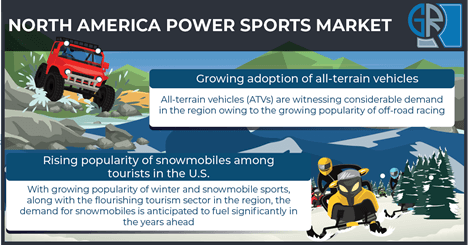With escalating popularity of X-games and off-roading recreational activities, the North America power sports market is expected to expand exponentially in the coming years. In recent times, sporting companies have been emphasizing on the significance of bringing sustainable technology in powersports vehicles. For instance, in December 2021, Polaris in partnership with an electric vehicle company, Zero Motorcycle, launched its all-electric RANGER XP Kinetic UTV lashed with 110 hp motor, which offers 140 ft-lb of torque. Initiatives such as these are bound to augment the demand for power sports in North America in the years to come.
The growing focus of governments towards climate change due to excessive vehicle emissions is also driving significant adoption of sustainable automotive technology in the power sports industry.

Mentioned below are some key factors expected to impact the overall market trends in the upcoming years:
In 2020, the COVID-19 pandemic had negatively impacted the growth of power sports business in North America owing to stringent restrictions on public events and gatherings enforced by the governments in the region, to curb the rapid spread of the virus. This led to the cancellation of various outdoor sports events and recreational activities, which significantly hampered the demand for power sports vehicles.
The reduced production of vehicles due to the pandemic-enforced shutdown of industrial and business operations also impacted the overall industry expansion. However, rising government initiatives to bring back the economic activities on track by boosting COVID-19 vaccination programs and allowing manufacturing facilities to operate with strict adherence to COVID-appropriate-protocols are expected to bring rapid revival in the industry.
Growing adoption of all-terrain vehicles
All-terrain vehicles (ATVs) are witnessing considerable demand in the region owing to the growing popularity of off-road racing. The high power, excellent maneuverability, and ability of ATVs to be driven through various terrains complement their suitability for off-road racing as well as numerous utility purposes. As various off-road racing events are gaining substantial acceptance across the region, the adoption of all-terrain vehicles is slated to grow exponentially in the coming years.
For instance, the American Motorcyclists Association (AMA) sanction various ATV competitions in the country, such as ATV Extreme Dirt Track National Championship Series, ATV Motocross National Championship Series, Grand National Cross Country Series (GNCCs), and others, which have a considerable amount of followership in the country.
All-terrain vehicles are also widely adopted for utility purposes, such as touring, farming, and others, on account of their higher capacities and enhanced comfort. Moreover, their lower price as compared to other powersports vehicles, such as snowmobile or jet skis further complement their adoption to a large extent.
Rising popularity of snowmobiles among tourists in the U.S.
Snowmobiles are another type of power sports vehicle that observe high demand in North America, especially during winter. The swift mobility of snowmobiles in the deep snow allows their usability in snow-recreational activities as well as many utility applications, such as checking forest land, winter rescue work, repairing power & telephone lines, and providing winter transportation for tourists and professional conservationists.
With growing popularity of winter and snowmobile sports, along with the flourishing tourism sector in the region, the demand for snowmobiles is anticipated to fuel significantly in the years ahead. According to the Office of Travel and Tourism Industry, approximately 2,002,051 tourist arrivals were reported across the U.S. in July 2021. This was majorly attributed to the ease of international flight restrictions owing to the substantial decline in COVID-19 cases in that period of time.


